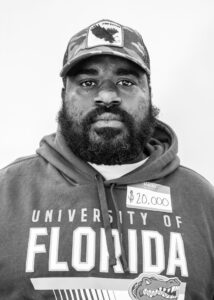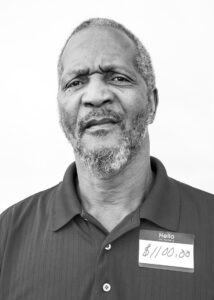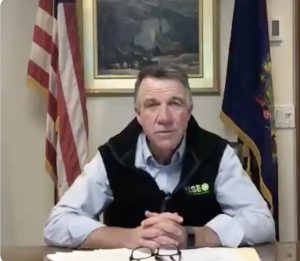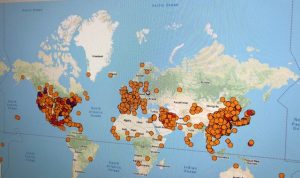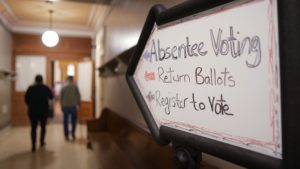Local Journalism
True investigative journalism.
October 14, 2021When It Costs $53,000 to Vote
Mr. Winter is a staff photographer on assignment in Opinion. Mr. Wegman is a member of the editorial board.
‘Earlier this year we asked Floridians whose voting rights had been denied because of a criminal conviction to sit for photographs, wearing a name tag that lists not their name but their outstanding debt — to the extent they can determine it. This number, which many people attempt to tackle in installments as low as $30 a month, represents how much it costs them to win back a fundamental constitutional right, and how little it costs the state to withhold that right and silence the voices of hundreds of thousands of its citizens. The number also echoes the inmate identification number that they were required to wear while behind bars — another mark of the loss of rights and freedoms that are not restored upon release.
This is the way it’s been in Florida for a century and a half, ever since the state’s Constitution was amended shortly after the Civil War to bar those convicted of a felony from voting. That ban, like similar ones in many other states, was the work of white politicians intent on keeping ballots, and thus political power, out of the hands of millions of Black people who had just been freed from slavery and made full citizens.
Even as other states began reversing their own bans in recent years, Florida remained a holdout — until 2018, when Floridians overwhelmingly approved a constitutional amendment restoring voting rights to nearly everyone with a criminal record, upon the completion of their sentence. (Those convicted of murder or a felony sexual offense were excluded.)
Democratic and Republican voters alike approved the measure, which passed with nearly two-thirds support. Immediately, as many as 1.4 million people in the state became eligible to vote. It was the biggest expansion of voting rights in decades, anywhere in the country.
That should have been the end of it. But within a year, Florida’s Republican-led Legislature gutted the reform by passing a law defining a criminal sentence as complete only after the person sentenced has paid all legal financial obligations connected to it.
Even relatively small debts can be permanently disenfranchising for people who simply don’t bring in enough money to pay them off. General Peterson, 63, served a total of three and a half years on three convictions and believes he still owes around $1,100 in fees. He is retired and using his Social Security check to make monthly payments of $30 on the debt. “You want to help me pay it? That’d be fine with me,” he said.’
The vacuum created by the collapse of independent local news in America has given rise to ghost papers, partisan hackery, unverified rumors, and worse. Yet, new cohorts of news organizations are taking root to fill that void, often supported by philanthropy, public contributions, and new creative means of sustainability. At stake is the information that all citizens need to participate in democracy. S. Mitra Kalita, co-founder and CEO of URL Media, a network of Black-and Brown-owned media organizations sharing content, distribution, and revenues, and Stewart Vanderwilt, president and CEO of Colorado Public Radio, discuss the changing landscape of news gathering with Vivian Schiller, executive director of Aspen Digital at the Aspen Institute.
Local Journalism
March 30, 2020‘Like many in business, trusted news organizations are being hit hard by this pandemic. If you can, please consider subscribing to your local paper or contributing to a VT news organization. You deserve transparency and the truth, and they work hard to keep you informed.
-Vermont Governor Phil Scott
NYTimes
Ben Smith
“Abandon most for-profit local newspapers, whose business model no longer works, and move as fast as possible to a national network of nimble new online newsrooms. That way, we can rescue the only thing worth saving… the journalists.”
Bail Out Journalists. Let Newspaper Chains Die.
The coronavirus is likely to hasten the end of advertising-driven media, our columnist writes. And government should not rescue it.
“There’s all this ‘doom and gloom for local journalism stories’ that have happened in the last week or so, and I hope that other people see what we’re doing and understand that the important thing is the journalism — it’s the stories, it’s the investigations — that’s what matters,” Ken Ward said. He will also be on the staff of the nonprofit investigative powerhouse ProPublica and will have support from Report for America, another growing nonprofit organization that sends young reporters to newsrooms around the country.
The news business, like every business, is looking for all the help it can get in this crisis. Analysts believe that the new federal aid package will help for a time and that the industry has a strong case to make. State governments have deemed journalism an essential service to spread public health information. Reporters employed by everyone from the worthiest nonprofit group to the most cynical hedge fund-owned chain are risking their lives to get their readers solid facts on the pandemic, and are holding the government accountable for its failures. Virtually every news outlet reports that readership is at an all-time high. We all need to know, urgently, about where and how the coronavirus is affecting our cities and towns and neighborhoods.
So what comes next? That decision will be made in the next few months — by public officials, philanthropists, and other tech companies, and people like you.
The right decision is to consistently look to the future, which comes in a few forms. The most promising right now is Ms. Green’s dream of a big new network of nonprofit news organizations across the country on the model o The Texas Tribune, which Mr. Thornton co-founded. There are also a handful of local for-profit news outlets, like The Seattle Times, The Los Angeles Times and The Boston Globe, with rich and civic-minded owners, and The Philadelphia Inquirer, which is owned by the non-profit Lenfest Institute for Journalism. And there is a generation of small, independent membership or subscription sites and newsletters like Berkeleyside.
Elizabeth Green, a founder of Chalkbeat, a nonprofit news organization reporting on education issues, in Washington, D.C.
[Avi Schiffmann]
The High Schooler Who Became a COVID-19 Watchdog
The New Yorker
by Brent Crane
In December, DT said, “We have a problem that, a month ago, nobody thought about.” Well, somebody did. On December 29th, as DT vacationed with his family at Mar-a-Lago, Avi Schiffmann, a seventeen-year-old from Washington State, launched a homemade Web site to track the movement of the coronavirus. Since then, the site, ncov2019.live, has had more than a hundred million visitors. “I wanted to just make the data easily accessible, but I never thought it would end up being this big,” the high-school junior said last week over FaceTime. Schiffmann, gap-toothed and bespectacled, was sitting on his bed wearing a blue T-shirt and baggy pajama bottoms. It was late morning. He was at his mother’s house, on Mercer Island, outside Seattle.
Using a coding tactic known as “web-scraping,” Schiffmann’s site collates data from different sources around the globe—the W.H.O., the C.D.C., Yonhap News Agency in South Korea—and displays the latest number of covid-19 cases. It features simple graphics and easy-to-read tables divided by nation, continent, and state. Data automatically updates every minute. In a politicized pandemic, where rumor and panic run amok, the site has become a reputable, if unlikely, watchdog.
He began teaching himself to code when he was seven, mainly by watching YouTube videos, and has made more than thirty Web sites. “Programming is a great creative medium,” he said. “Instead of using a paintbrush or something, you can just type a bunch of funky words and make a coronavirus site.” One of his first projects, in elementary school, was what he calls “a stick-figure animation hub.” Later sites collated the scores for his county’s high-school sports games, aggregated news of global protests, and displayed the weather forecast on Mars. “His brain is constantly going from one thing to another, which is good, but I also try to focus him in,” his mother, Nathalie Acher, said. “I’m not techy at all myself. I see it as just really boring. He sees it as an art form.”
Schiffmann took the virus threat seriously before many others did. “I’ve been kind of concerned for a while, because I watched it spread very fast, and around the entire world. I mean, it just kind of went everywhere.” He took his own precautions. “I got masks a while ago. I got, like, fifteen for seventeen dollars. Now you can’t even buy a single mask for, like, less than forty.” His mother chimed in. “I wish I had listened to him,” she said. “But, in his teen-ager way, he’d come down the stairs with his eyes huge and be, like, ‘There are fifty thousand more cases!’ and I’d be, like, ‘Yeah, but they’re over there, not here.’ ”
Her son is a C student.
Now that the grownups of the world are finally, and appropriately, freaking out, it is hard for Schiffmann not to feel righteous vindication. “If you told someone three months ago that we should spend, like, ten billion dollars in upgrading the United States’ health care, they would have been, like, ‘Nah,’ ” he said. “Now, everyone’s, like, ‘Oh, my God, yes.’ But this is the kind of stuff we should have done a long time ago.”
Young people give me so much hope. ❥ -dayle
American Journalism
December 29, 2019An upcoming documentary, “Stripped for Parts: American Journalism at the Crossroads,” documents the fight being waged by newspapers nationwide to continue reporting the news despite growing threats to push local journalism toward extinction.
[Society for Professional Journalists]
This film is currently in production.
Kovno Communications, Inc. (KCI) is a non-profit, 501(c)(3) organization which was founded in 1997 with a mission to develop, produce and distribute film and video for educational purposes. Rick Goldsmith, two-time Academy Award-nominated director, is the principal filmmaker and President of Kovno Communications.
“We welcome your support as we document this important story of local journalism in America. Donate to our project. All contributions are tax-deductible.”
Local Journalism Reigns
December 21, 2019Queens man impeached
Dec. 19, 2019
by Victoria Merlino
Former Jamaica Estates resident Donald Trump was impeached Wednesday by the U.S. House of Representatives. He is the third president to be impeached in United States history — and the first from Queens.
Trump is accused of pressuring the Ukrainian government to investigate political rival and Democratic candidate for president, Joe Biden, and of withholding military aid until the Ukrainians conducted the investigation. He is also accused of obstructing the Congressional investigation.
Trump fired off a series of tweets on Thursday over the impeachment process, calling it “presidential harassment” and directing ire at House Speaker Nancy Pelosi.
“Pelosi feels her phony impeachment HOAX is so pathetic she is afraid to present it to the Senate, which can set a date and put this whole SCAM into default if they refuse to show up! The Do Nothings are so bad for our Country!” he wrote.
The charges will be sent to the Republican-controlled Senate, initiating a trial that could have lasting ramifications in the 2020 presidential election.
The entire Queens House delegation voted in favor of impeachment.
“Today, I voted to impeach President Donald Trump … I did so with a heavy heart for our country, but a clear conscience. I did so, because, above all, I took an oath to support and defend the Constitution of the United States,” U.S. Rep. Grace Meng wrote in a statement on Twitter.
“No normal person would be able to get away with attempting to extort a foreign power to compromise our country,” U.S. Rep. Alexandria Ocasio-Cortez tweeted. “But all too often, the most corrupt and powerful people grow so accustomed to life with impunity that standard accountability feels to them like unjust persecution.”
Trump’s old Jamaica Estates home, where he lived as an infant until he was four years old, went back on the market after it was sold to a Chinese investor and rented on Airbnb for $725 a night, according to Curbed.
Trump’s parents’ graves are located at All Faiths Cemetery in Middle Village. The cemetery was slapped with a lawsuit by New York Attorney General Letitia James earlier this year for allegedly misappropriating funds.
[Buried mid-paper.]
The State of the 4th Estate
December 20, 2018AP
“The number of journalists killed worldwide in retaliation for their work nearly doubled this year, according to an annual report by the Committee to Protect Journalists.”
- “34 journalists were killed in retaliation for their work, … while at least 53 were killed overall. That compares to 18 retaliation killings among the 47 deaths documented by the committee in 2017.”
- “[J]ournalists have died in combat or crossfire, or on other dangerous assignments. The deadliest country for journalists this year has been Afghanistan, where 13 journalists were killed.”
- “[T]he imprisonment of journalists has [also] been on the rise.”
“Media freedom group Reporters Without Borders said … the U.S. made it into the top five deadliest countries for journalists this year for the first time, with six dying, including four who were among five people killed by a gunman who opened fire in the offices of Maryland newspaper Capital Gazette.”
The Fresno Bee and the War on Local News
Local newspapers like The Fresno Bee have long been an endangered institution in America, and that was before California Rep. Devin Nunes began waging a public campaign against his hometown paper. Zach Baron spent time with the reporters fighting to keep news alive in an age when the forces they cover are working equally hard to destroy them.
“In October, the University of North Carolina’s School of Media and Journalism released a study that estimated that a full 20 percent of all local newspapers have gone out of business or merged since 2004. Since then, an additional 1,300-plus communities in the United States have found themselves without any news source about their own city, town, or county. “Our sense of community and our trust in democracy at all levels suffer when journalism is lost or diminished,” the authors of the report wrote. “In an age of fake news and divisive politics, the fate of communities across the country—and of grassroots democracy itself—is linked to the vitality of local journalism.”
https://www.gq.com/story/fresno-bee-and-war-on-local-news/amp?__twitter_impression=true
New owners of local news franchises are lest invested in local news: Industry economics have prioritized national news over local.
- A study from Duke University’s DeWitt Wallace Center for Media & Democracy earlier this year found that only 17% of news stories in a community are actually local, meaning they’re actually about or having taken place within a municipality.
- And less than half of the news stories (43%) provided to a community by local media outlets are original.
- This is often because holding groups are consolidating resources, forcing local reporters to focus on national stories that reach bigger audiences.
The rise of paywalls means that high quality information will funnel to elites: As the digital advertising landscape continues to evolve, it’s becoming evident that digital ad dollars will continue to flow primarily to tech platforms rather than news publishers.
- Because of this, publishers are setting up paywalls (subscriptions, members, etc.) to survive. And while more Americans say they are willing to pay for news, those with higher levels of education are more likely to do so. In all, 66% of adults with a college degree pay for news, compared to 43% of people with a high school diploma or less.
-
“There is a growing gap in public knowledge between the information-rich and the information-poor,” says Rodney Benson, chair of NYU’s Department of Media.
- Benson cites other Westernized countries that have less of an information gap because of widely-available publicly-funded broadcast television. Examples include the BBC in the U.K., SVT in Sweden or ZDF/ARD in Germany.
What’s next? The death of local news in rural America is expected to accelerate.
[AXIOS]
“Increasingly, journalism serves as a powerful force for exclusion, for keeping quality information away from those who need it most, for discouraging anyone but the richest, most educated citizens from participating in the public conversation.”
— Rodney Benson, chair of NYU’s Department of Media Culture & Communication
Local journalism.
December 6, 2018The Charlotte Observer’s reporting on election fraud is indicative of our need for local journalism, investigative reporting…specifically newspapers…and the role of the 4th Estate, a free press.
NC election scandal probe focuses on Charlotte-area political consultant
https://www.charlotteobserver.com/news/politics-government/election/article222690460.html
In response to “At center of voter fraud scandal, a convicted felon and ‘grassroots’ campaigner” :
It looks like the electoral fraud we’ve been searching for the past few years has been found in Bladen County. But as it turns out, it has nothing to do with non-citizens voting, someone hacking the voting machines or people impersonating other voters because NC doesn’t require ID.
Assuming the evidence holds up, the real problem is old-fashioned vote theft happening in razor-close elections and carried out by people getting paid out of a candidate’s campaign funds. It’s the real thing, and it has nothing to do with voter ID.
Photo: Gregory Rec/Portland Press Herald via Getty Images
The McClatchy Company is a publicly traded American publishing company based in Sacramento, California, and incorporated in Delaware.[2] It operates 29 daily newspapers in fourteen states and has an average weekday circulation of 1.6 million and Sunday circulation of 2.4 million. [wikipedia]
As ubiquitous as connectivity may seem for those who live in cities or suburbs with comfortable incomes, here’s the reality:
- Less than one-fifth of Americans live in a neighborhood where at least 80% of the residents have broadband, according to a report last year from the Brookings Institution.
- Nearly one-in-five teens are sometimes unable to complete homework because of lack of a reliable computer or internet connection, per Pew.
- Local news and information is becoming scarce and hard to access: More than 500 newspapers have closed or merged in rural communities since 2004.
The big picture: There are two types of “digital divide” operating today:
- The geographic divide: Rural and other areas are underserved because it doesn’t make financial sense for companies to invest in infrastructure.
- The economic divide: Infrastructure is in place, but lower-income families lack affordable access and devices.
Why it matters: These divides are colliding and combining in troubling ways — and creating a whole spectrum of education, information and privacy inequality.

The media haves and have nots.
- A record number of newspaper sales and closures/mergersvia the seven biggest newspaper investment owners have increased over the past five years.
- Only 17% of local news stories in a community are actually local, meaning they’re about or having taken place within a municipality, per a study from Duke earlier this year.
- While more people say they are willing to pay for news, those with higher levels of education are more likely to do so, per a study from the American Press Institute.
Between the lines: Benson says finding ways to create a plurality in types of news ownership will help to decrease the growing information gap in the U.S.
The bottom line: There’s a real news and information divide between rural and urban/suburban communities as well as between the poor and rich in the United States.
“Increasingly, journalism serves as a powerful force for exclusion, for keeping quality information away from those who need it most, for discouraging anyone but the richest, most educated citizens from participating in the public conversation.”— Rodney Benson, chair of NYU’s Department of Media Culture, and Communication
Digital Divide.
As ubiquitous as connectivity may seem for those who live in cities or suburbs with comfortable incomes, here’s the reality:
- Less than one-fifth of Americans live in a neighborhood where at least 80% of the residents have broadband, according to a report last year from the Brookings Institution.
- Nearly one-in-five teens are sometimes unable to complete homework because of lack of a reliable computer or internet connection, per Pew.
- Local news and information is becoming scarce and hard to access: More than 500 newspapers have closed or merged in rural communities since 2004.
The big picture: There are two types of “digital divide” operating today:
- The geographic divide: Rural and other areas are underserved because it doesn’t make financial sense for companies to invest in infrastructure.
- The economic divide: Infrastructure is in place, but lower-income families lack affordable access and devices.
Why it matters: These divides are colliding and combining in troubling ways — and creating a whole spectrum of education, information and privacy inequality.
Media pivots away from advertising
For decades the primary source of revenue for media companies was advertising. But competition from technology companies and more privacy scrutiny are pushing most media companies to explore alternative forms of revenue, Axios’ Sara Fischer reports.
- Why it matters: Most media companies have to unwind years worth of sales and product infrastructure to make way for the transition. Not all will survive.
Most companies are looking for creative ways monetize their owned and operated channels and content, but the transition away from advertising and Facebook traffic has been difficult.
- Subscriptions and memberships: Bloomberg, Vanity Fair, Wired, Business Insider, Quartz, New York Magazine, The Atlantic, The Daily Beast, HuffPost
- Commerce: BuzzFeed, CNN, New York Times, NBC
- Content licensing deals: Vox, New York Times, BuzzFeed, Axios, Refinery29, Conde Nast Entertainment
- Technology licensing deals: The Washington Post (Arc), New York Magazine (Clay), Vox Media (Chorus), Hearst (MediaOS)
Be smart: Most companies are in the experimental phase, and haven’t yet figured out what their long-term strategy for growth will be — if there is one.





